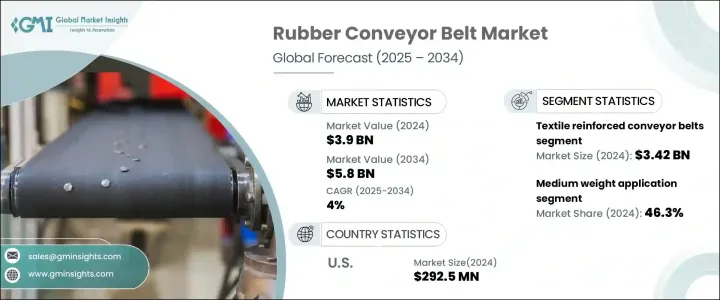
세계의 고무 컨베이어 벨트 시장은 2024년에 39억 달러에 이르고, 2025년부터 2034년까지 연평균 복합 성장률(CAGR) 4%를 보일 것으로 예측됩니다.
산업 자동화가 중시되고, 다양한 산업에서 기계화 시스템의 통합이 진행되고 있는 것이 시장 확대를 촉진하는 주요 요인 중 하나입니다. 고무 컨베이어 벨트는 광범위한 산업 공정에서 필수 부품으로 떠오르고 있으며, 벌크 재료 및 무거운 물체 취급에 유연성, 신뢰성 및 고성능을 제공합니다.

광업, 건설, 제조, 식품 가공, 물류 등의 산업에서는 작업 합리화, 다운타임 최소화, 생산성 향상을 위해 컨베이어 벨트의 도입이 진행되고 있습니다. IoT 지원 센서 및 자동화 제어를 포함한 스마트 기술의 통합은 또한 컨베이어 시스템의 운영 방법을 변화시키고 있으며, 실시간 모니터링 및 유지보수 경고를 제공하면서 가혹한 산업 환경을 견딜 수 있는 고급 고무 컨베이어 벨트 수요를 촉진하고 있습니다.
| 시장 범위 | |
|---|---|
| 시작 연도 | 2024년 |
| 예측 연도 | 2025-2034년 |
| 시작 금액 | 39억 달러 |
| 예측 금액 | 58억 달러 |
| CAGR | 4% |
시장은 재료 유형에 따라 구분되며, 스틸 보강, 섬유 보강, 솔리드 직물 벨트가 주요 카테고리입니다. 뛰어난 강도와 유연성에 의해 크고 마모하기 쉬운 짐을 일상적으로 취급하는 광업이나 건설 등의 중하중 산업에서 선호되고 있습니다. 부식성이 높고 유지보수가 불필요한 것으로 알려져 있으며, 내구성이나 성능에 타협하지 않고 장기적인 운전 경비 최적화를 목표로 하는 업계에 있어서 비용 효율적인 솔루션으로 자리매김하고 있습니다.
용도의 관점에서 고무 컨베이어 벨트 시장은 경량 벨트, 중량 벨트, 고중량 벨트로 분류됩니다. 산업 오토메이션의 동향과 효율적인 자재관리 시스템에 대한 수요 상승에 따라, 중량 컨베이어 벨트는 장수명과 유지관리 비용의 삭감을 실현하면서, 진화하는 산업 요구에 대응하기 위해 채용이 증가하고 있습니다.
미국의 고무 컨베이어 벨트 시장은 2024년에 2억 9,250만 달러를 창출해 2025년부터 2034년까지 연평균 복합 성장률(CAGR) 4.1%를 보일 것으로 예측됩니다. 자동차는 자재관리의 효율성, 작업 안전성, 예측 유지보수 기능을 강화하기 위해 스마트 센서와 IoT 연결을 갖춘 인텔리전트 컨베이어 솔루션을 빠르게 도입하고 있습니다.
The Global Rubber Conveyor Belt Market reached USD 3.9 billion in 2024 and is projected to grow at a CAGR of 4% between 2025 and 2034. The growing emphasis on industrial automation and the rising integration of mechanized systems across diverse industries are some of the key factors driving market expansion. As companies continue to focus on improving operational efficiency and reducing manual labor, the adoption of automated material handling solutions is accelerating at a rapid pace. Rubber conveyor belts have emerged as indispensable components in a wide range of industrial processes, offering flexibility, reliability, and high performance in handling bulk materials and heavy loads.

Industries such as mining, construction, manufacturing, food processing, and logistics are increasingly deploying conveyor belts to streamline operations, minimize downtime, and enhance productivity. Furthermore, the ongoing investments in infrastructure development and the rising demand for efficient bulk material transportation are adding significant momentum to the growth of the global rubber conveyor belt market. The integration of smart technologies, including IoT-enabled sensors and automation controls, is also transforming the way conveyor systems are operated, driving demand for advanced rubber conveyor belts that can withstand harsh industrial environments while offering real-time monitoring and maintenance alerts.
| Market Scope | |
|---|---|
| Start Year | 2024 |
| Forecast Year | 2025-2034 |
| Start Value | $3.9 Billion |
| Forecast Value | $5.8 Billion |
| CAGR | 4% |
The market is segmented based on material type, with steel-reinforced, textile-reinforced, and solid woven belts being the primary categories. Textile-reinforced conveyor belts accounted for a significant portion of the global market, generating USD 3.42 billion in 2024, and are anticipated to expand at a 4% CAGR through 2034. Their superior strength and flexibility make them a preferred choice in heavy-duty industries such as mining and construction, where handling large and abrasive loads is a routine operation. Textile-reinforced belts are also known for their corrosion resistance and lower maintenance needs compared to steel-reinforced belts, positioning them as cost-effective solutions for industries looking to optimize long-term operational expenditures without compromising on durability and performance.
From an application standpoint, the rubber conveyor belt market is categorized into light, medium, and heavy-duty belts. The medium-weight conveyor belts segment dominated the market in 2024, securing a 46.3% share. These belts are widely recognized for their balance between flexibility, strength, and affordability, making them suitable for a wide range of applications, including mining, construction, and manufacturing. With the growing trend of industrial automation and rising demand for efficient material handling systems, medium-weight conveyor belts are increasingly adopted to meet evolving industry needs while offering long service life and reduced maintenance costs.
The U.S. Rubber Conveyor Belt Market generated USD 292.5 million in 2024 and is forecasted to grow at a CAGR of 4.1% from 2025 to 2034. The country's advanced industrial infrastructure and the widespread adoption of automation technologies in sectors such as manufacturing, mining, and logistics are propelling the demand for high-performance conveyor belts. Leading U.S. manufacturers are rapidly incorporating intelligent conveyor solutions equipped with smart sensors and IoT connectivity to enhance material handling efficiency, operational safety, and predictive maintenance capabilities.